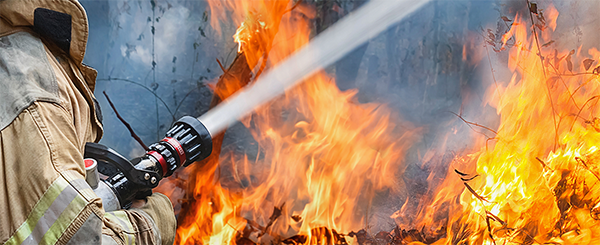
A polar vortex affecting much of the country. Fires in California and Colorado. Floods in the Midwest, Mid-Atlantic and California. Earthquakes in Oklahoma. And that’s just within the last few months. No matter where your clients are located, there’s always the potential for a natural disaster. That’s why it’s crucial to prepare ahead nature’s next curve ball, with a business continuity plan. It’s your strategy for being prepared.
Last year, more than 10 million acres burned in wildfires, compared with 5.4 million in 2016, according to Insurance Information Institute. Also in 2017 were two of the top 10-ranked significant flood events over the past 12 years (Hurricanes Harvey and Irma). Last year there were nearly 1,000 tornadoes in the U.S. alone – and 2018 was deemed one of the least active tornado years in recent history. All add up to one truth: It pays to be prepared for a natural disaster with a business continuity plan, so that your commercial client is better positioned for recovery.
We’re offering solutions that will be applicable to all types of Mother Nature’s temper tantrums. Some will be applicable to your locations; others will not (floods vs. fires, for instance). Still, here are 10 ways to plan ahead to minimize risks, with a disaster plan.
1. Identify hazards
As in any risk assessment plan, first identify your hazards. What is stored in an open yard that will be damaged? What’s the risk of fire, whether from natural or man-made sources? How about a risk of flood? If you’re in an earthquake-prone area, what steps can you take to secure your building and its contents? If the disaster occurs during work hours with little-to-no-warning, how will you provide for staff?
2. Check insurance coverage
Now’s the time they need to confer your insurance company to ensure you’re covered for natural calamities occurring most often in your area. According to Florida’s Office of Insurance Regulation (as reported in PropertyCasualty360), Hurricane Irma impacted 90,000 businesses and 58,000 commercial properties. Many received the insurance coverage they expected; others found out the hard way that they didn’t have the coverage they assumed they had.
Have you made improvements to the property, added new equipment or increased inventory? Tell your agent. Yes, it may slightly increase your premiums, but otherwise, these enhancements may not be covered without an increase to policy limits.
Consider additional flood or earthquake insurance, if you’re in a flood or earthquake-prone area. Typical property insurance policies exclude these, so additional coverage may be needed.
Also consider adding business interruption insurance, which helps cover payroll and the lost profits that would’ve been earned, based on your sales records, had the disaster not occurred. It also helps pay ongoing operating expenses that continue, even though you’re temporarily not in business.
3. Have a communication plan in place
Your business continuity plan should include a list of important phone numbers with a plan as to how you’ll contact employees, customers, suppliers and more and keep it in multiple places (especially in the Cloud). It’s also a good idea to file a copy of your disaster plan with local law enforcement officials so they’re better equipped to aid you in case of emergency. And once you’re back in business, you’ll want to quickly – and continually – communicate via social media and other channels appropriate for your tribal business.
4. Train employees
Included in your written plan should be two sections: one for evacuation, and one for sheltering-in-place. Your emergency plan should include a kit of emergency supplies (view FEMA’s list ), how you will communicate with employees and how they can communicate with you, and steps to take to secure your building. Employees should be familiarized with all of these procedures.
5. Protect computer data
Important records and papers should be duplicated and stored in a secure (offsite) location. Use a data storage firm that offers offsite and online backups of computer data. Update back-ups regularly.
6. Decide how to strengthen the supply chain
Disruptions may occur in your supply chain, so it’s crucial to include these risks in your business disaster plan. You may be cut off from vendors who supply critical inventory and supplies. You may be unable to distribute or sell their goods, due to the simple fact that customers can’t get to you temporarily (or longer). All create a crucial issue, quickly draining financial reserves and weakening customer relationships. What’s your Plan B, in case of an emergency?
7. Identify critical business activities
If you cannot afford to shut down operations temporarily, what will you need to run the business elsewhere? What resources need to be on hand? What alternative facilities, supplies or equipment can you use? Consider a reciprocity agreement with another business: If you’re temporarily out of commission, you can conduct business from the alternate location. And if the reciprocating business is badly damaged, you’ll agree to allow them to use your facilities.
8. Identify the contractors and salvage specialists to work with
Now – before a disaster – is a good time to vet any contractors that will be needed in the event of major damage. We suggest that you meet these business owners ahead of time to solidify your business continuity plan.
Using a business continuity plan after the event:
9. Photograph & document damages and temporary repairs
Although your first impulse is to protect your property from any further damage from the elements, the first thing you’ll need to do is quickly snap some photos or video with a smartphone, showing as much detail of the damage as possible. Know what temporary repairs are covered in your policy, so that you’re not unwittingly impeding your claim. Keep records (and take photos) of temporary repairs made prior to meeting with the adjuster.
10. Protect workers
Typically, cleanup and recovery operations fall to you and your employees. Minimize hazards to your team as they begin clean-up to get back to business. Before anyone gets started, communicate any dangers and hazards to watch for. This may include downed power lines, wildlife taking refuge in the structure, standing water which may mask other issues, structural damage or chemical spills.
They should be dressed appropriately for the hazards: hard hats, safety glasses, heavy work gloves and sturdy boots or shoes. Provide water and ensure the group takes frequent breaks. If chemical spills or animal or human waste is present, provide disinfecting solutions to be used prior to eating/drinking and at the end of the shift. Workers should also be trained in the proper use, cleaning, decontamination and maintenance of personal protective equipment. First aid kits should be on hand to quickly attend to any issues.
If they’re using a generator, it should be adequately vented. Using power tools? Their electrical supply should be equipped with GFI protection. Guards and safety devices should be in place for all equipment, such as chainsaws. Avoid using extension cords in wet areas.
This article first appeared on our Tribal Program website. It has been modified to better fit the needs of our claims solutions clients.
Resources:
https://www.zurichna.com/en/knowledge/articles/2017/12/post-disaster-recovery-keeping-your-workers-safe
https://www.propertycasualty360.com/2018/07/02/learning-from-hurricane-irma-properly-insuring-and/ https://www.iii.org/research-data/catastropheshttps://www.zurichna.com/en/knowledge/topics/severe-weather https://www.thesilverlining.com/safety-resources/tips-to-help-avoid-losses/commercial-business-tips/can-your-business-survive-a-natural-disaster-
http://www.inguard.com/blog/3-tips-on-how-to-protect-your-business-against-natural-disasters
https://www.thesimpledollar.com/protecting-your-business-from-natural-disasters/https://www.fema.gov/media-library/assets/documents/13232
